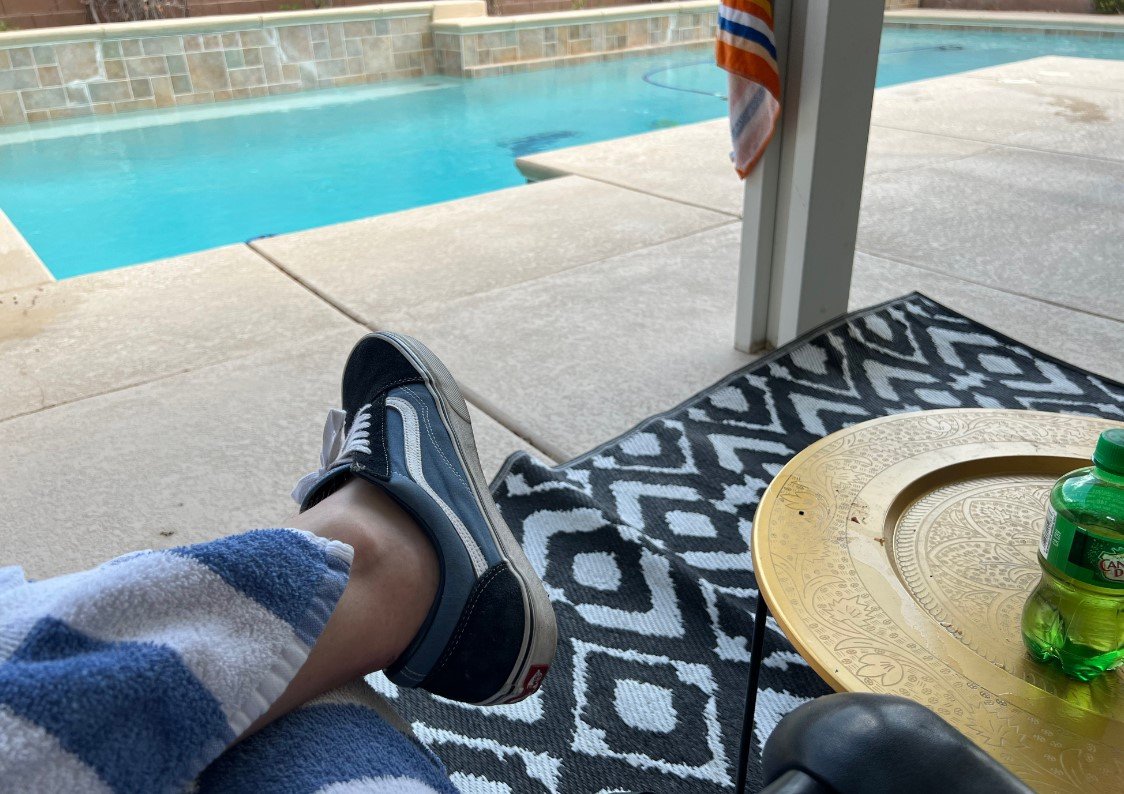Swimming has long been recognized as a low-impact exercise that can improve cardiovascular health, muscle strength, and overall fitness levels. With the pandemic limiting access to public pools, many homeowners are opting to install their own lap pools in their backyards. These backyard lap pools not only provide a convenient option for aquatic exercise, but they also offer a number of other benefits for health and relaxation.
Apart from providing a space for aquatic exercise, lap pools can also be used for hydrotherapy. The buoyancy of water can aid in relieving joint pain and reducing stress, making it a great option for those with chronic pain or injuries. In addition, swimming can help reduce stress and improve mental health, making it an ideal option for those looking for a way to unwind and disconnect.

With more people spending time at home, the trend of backyard lap pools is on the rise. Whether you’re a serious swimmer or simply looking for a low-impact way to stay active, a lap pool in your backyard can provide the perfect solution for health, fitness, and relaxation.
Relaxation and stress-relief benefits
The convenience of having a personal swimming pool at home:
One of the most significant benefits of having a lap pool in your backyard is the convenience of having a personal swimming pool at home. Unlike public swimming pools, you won’t have to drive miles away to enjoy a good swim, nor will you have to worry about the cost of membership fees. Having a lap pool in your backyard means that you can take a dip in the water anytime you want, without worrying about time restrictions or waiting in line.
Private and customizable design options:
Another advantage of having a lap pool in your backyard is the private and customizable design options it offers. Unlike public pools, you have full control over the design of your lap pool, which means you can customize it to fit your unique style and preferences. You can choose everything from the shape of the pool to the materials used in its construction, allowing you to create a backyard oasis that is both functional and beautiful.
Promotes daily exercise and healthy lifestyle habits:
One of the most significant benefits of having a lap pool in your backyard is the promotion of daily exercise and healthy lifestyle habits. Swimming is an excellent form of low-impact exercise that provides a full-body workout, making it an ideal way to stay active and healthy. Having a lap pool in your backyard means that you can easily incorporate swimming into your daily routine, helping you to stay fit, healthy, and active all year round.
Aquatic exercise opportunities with a lap pool
A lap pool can be an excellent tool for aquatic exercise, offering a full-body workout with low-impact movements. Exercising in the water can be beneficial for individuals with joint issues or those who want to avoid high-impact activities.
Swimming in a lap pool can help with weight loss, muscle building, and cardiovascular health. It can burn calories, tone muscles, and improve endurance and breathing. A 30-minute swim session can burn up to 400 calories, making it a great option for those looking to lose weight.
In addition to swimming, lap pools can also be used for a variety of aquatic exercises. Water aerobics, for example, can provide a great cardiovascular workout while being gentle on the joints. Resistance exercises can also be performed in the water, making it an effective way to build muscle strength.
One of the benefits of a lap pool is that it is suitable for all ages and fitness levels. Children can learn to swim, while seniors can use it for low-impact exercise. Athletes can use the pool for cross-training or rehabilitation, while beginners can start with simple exercises and gradually increase the intensity.
Health benefits of lap pools for hydrotherapy and water therapy:
1. Reduced joint pain and inflammation:
Lap pools can be incredibly beneficial for those who suffer from joint pain and inflammation. The buoyancy of the water allows for a low-impact workout, reducing the strain on joints while still providing an excellent cardiovascular workout. Additionally, the warmth of the water can help soothe sore muscles or achy joints, making it an excellent option for those who suffer from conditions like arthritis. Swimming laps are also an excellent way to exercise without putting undue pressure on your joints, making it an ideal option for those who may have limitations due to injury or chronic conditions.
2. Improved mobility and flexibility:
Swimming in a lap pool can help improve your mobility and flexibility. The resistance of the water makes it challenging to move, which can help you build muscle strength and endurance. Additionally, because swimming is a low-impact activity, it can help improve your range of motion without putting undue stress on your joints. This can be particularly beneficial for those who are recovering from an injury or surgery that has limited their range of motion.
3. Effective treatment for certain medical conditions:
Swimming is an excellent form of exercise for those who suffer from certain medical conditions. For example, it can be beneficial for those who have suffered a stroke or have a spinal cord injury, as swimming can help improve coordination and balance. Additionally, swimming can be an effective form of therapy for those who suffer from chronic pain or conditions like fibromyalgia, as the water can help reduce inflammation and provide a soothing effect on the body. Those who suffer from chronic stress may also find swimming laps to be incredibly calming and reduce anxiety levels. In general, swimming laps can be an excellent form of hydrotherapy and water therapy, providing numerous benefits for both physical and mental health.
Lap Pool for Home Workout
Using a lap pool for a home workout is a great way to stay in shape and maintain a healthy lifestyle. With a lap pool, homeowners have the option of using different types of equipment to vary their workout routine. For instance, pool weights and resistance bands can be used for strength training exercises, while water noodles and kickboards can be used for cardio workouts. The resistance of the water also provides a challenging workout that helps build endurance and improves overall fitness.
A lap pool is an excellent choice for cross-training as well. Incorporating different workouts, such as swimming, running, or strength training, can help improve overall fitness, increase cardiovascular endurance, and reduce the risk of injury. Furthermore, swimming is a low-impact activity, which means less strain on joints and muscles, making it an ideal form of exercise for people who suffer from joint pain or other injuries.
Another advantage of using a lap pool for home workouts is that it’s a cost-effective alternative to a gym membership. With the increasing cost of gym memberships, having a lap pool at home is a smart investment that will save money in the long run. Additionally, it’s a convenient alternative for those who work long hours or have limited time for exercise.
Lap Pool Installation and Maintenance:
Installing a lap pool in your backyard can add both beauty and functionality to your home. However, proper installation and maintenance are essential in order to ensure the longevity and safety of your pool. Here are some key points to consider:
Professional Installation Options:
Lap pools can be installed in a variety of ways, the most common being in-ground or above-ground. It is important to work with a professional installer who has experience with lap pools and can guide you in determining the best location and design for your pool. They can also help you navigate any local regulations or permits that may be required. An experienced installer will ensure that the pool is installed properly and meets all safety standards.
Common Pool Maintenance Tasks and Tips:
Once your lap pool is installed, it is important to keep up with regular maintenance. This includes cleaning and maintaining the water quality, as well as checking for any damage or wear and tear. Here are some common maintenance tasks and tips:
1. Regular cleaning: A lap pool should be cleaned at least once a week to remove any debris and excess chemicals. You can use a pool vacuum or skimmer to remove any leaves, dirt, or other debris from the water, and a pool brush to scrub the walls and floor of the pool.
2. Water quality: Maintaining the appropriate pH balance and chlorine level is crucial for keeping your lap pool safe and clean. pH levels should be between 7.4 and 7.6, while chlorine should be kept between 1-3 parts per million.
3. Check for leaks: A leaking pool can cause damage to the surrounding area and lead to costly repairs. Check for leaks regularly, especially around the fittings and pipes.
4. Proper winterization: If you live in an area with cold winters, it is important to properly winterize your lap pool to avoid damage from freezing water. This includes draining the pool, blowing out the pipes, and covering the pool with a winter cover.
Proper Pool Care to Ensure Longevity and Safety:
Proper care and maintenance of your lap pool can help to ensure its longevity and safety. It is important to follow all manufacturer’s recommendations for upkeep and repair and to work with experienced professionals when needed. Regular upkeep can help prevent costly repairs and ensure that your lap pool remains a beautiful and functional addition to your home.
Incorporating Lap Pool in Backyard Landscaping and Outdoor Living Spaces
Incorporating a lap pool into backyard landscaping and outdoor living spaces can be a great way to enhance your outdoor area. A lap pool is a long, narrow pool that is designed to allow you to swim laps and exercise in a relatively small space. It can be an excellent addition to your backyard, especially if you love to swim or want to improve your fitness.
Creative Design Options for a Visually Appealing Pool Area
When it comes to designing your lap pool, you have a lot of options to choose from. You can opt for a pool that is designed to blend into the surrounding landscape or one that is more modern and sleek. Some design options include adding decorative tiles, waterfalls, or even a hot tub to your pool area. There are also unique options such as infinity pools or pools that incorporate an underwater viewing area.
Combining Water Features and Landscaping for a Cohesive Backyard Aesthetic
One way to make your lap pool stand out is by incorporating water features and landscaping into the design. Adding stone walkways, native plants, and flowers around the pool can create a cohesive aesthetic that complements your home’s exterior. Additionally, incorporating a waterfall or fountain into the design can create a soothing ambiance when you are relaxing by your pool.
Utilizing the Pool Area for Outdoor Entertaining and Relaxation
Your lap pool can offer more than just a place to exercise. Consider adding comfortable outdoor furniture, umbrellas, and even a fire pit or outdoor kitchen to create a relaxing and entertaining outdoor space. You can also incorporate lighting options to make the area more inviting for evening use. By optimizing your lap pool area, you can transform your backyard into a private oasis for relaxation and entertainment.
Lap Pool Safety and Precautions
Lap pool safety and precautions are of utmost importance when constructing a lap pool in your backyard. These pools are typically smaller and designed for exercise and training purposes, they require that certain safety measures are put in place to reduce the risk of accidents and injuries. The following are important factors to consider when it comes to lap pool safety:
Basic pool safety guidelines:
As with any swimming pool, there are basic safety guidelines that must be followed to minimize the risk of accidents and injuries. Some of the general safety rules include supervising children at all times, never swimming alone, and avoiding diving or jumping into shallow water.
Keeping the pool area secure:
Lap pool safety can also be improved by ensuring that the pool area is secure. This means installing barriers such as fencing and pool covers to keep unauthorized individuals out when the pool is not in use. These safety features can also keep children and pets from accidentally falling into the pool, which could result in a dangerous situation.
Ensuring the safety of children and pets:
Children and pets should always be closely supervised when in and around the pool. Children who cannot swim or who are still learning to swim should wear floatation devices and should not be left unsupervised at any time. Pets should not be allowed in the pool area without supervision, and it’s best to teach them to swim in a designated area rather than in the lap pool itself.
Conclusion
In conclusion, having a lap pool in your backyard can provide a plethora of benefits to your overall health and wellness. The convenience of being able to exercise at your leisure, in the privacy of your own home, without having to worry about gym fees, memberships, or crowded pools, makes investing in a lap pool an attractive option. Additionally, the opportunity to create a beautiful outdoor living space, complete with seating areas, landscaping, and lighting, adds value to your home and enhances the overall aesthetic appeal of your property.
Therefore, we encourage you to consider investing in a lap pool for your backyard. Not only will it provide a convenient and enjoyable way to exercise, but it can also provide all of the benefits that come with spending time outside, such as stress relief, improved mood, and increased Vitamin D intake. So go ahead and make a splash with a lap pool in your backyard, and start reaping the many benefits it has to offer.
FAQs – Lap Pool
1. What is a lap pool?
A lap pool is a type of swimming pool that is primarily designed for swimming laps, exercise, and fitness training.
2. How big should my lap pool be?
The size of your lap pool will depend on your available space and your intended use. As a general rule, a lap pool should be at least 25 feet long, 8-10 feet wide, and 4-6 feet deep.
3. Do lap pools require a lot of maintenance?
Like any other swimming pool, lap pools require regular maintenance and cleaning. However, because lap pools are typically smaller than traditional swimming pools, they may require less upkeep.
4. Can I use my lap pool for other activities besides swimming laps?
Yes! Although lap pools are primarily designed for swimming laps, they can be used for other water-based activities, such as water aerobics, therapy, and relaxation.
5. Can lap pools be heated?
Yes, lap pools can be heated. This is especially useful if you live in a colder climate and want to use your pool year-round.
6. Is it difficult to install a lap pool in my backyard?
The installation process for a lap pool can be more complex than a traditional swimming pool. However, with the help of a professional pool contractor, the process can be relatively smooth and stress-free.
7. Will a lap pool increase the value of my home?
Yes, a lap pool can increase the value of your home, especially if you live in an area where swimming pools are popular amenities.
8. How much does a lap pool cost?
The cost of a lap pool can vary depending on the size, materials used, and features included. On average, you can expect to spend between $20,000 and $50,000 for a lap pool.
9. How long does it take to build a lap pool?
The construction timeline for a lap pool can vary depending on the complexity of the project. In general, you can expect the process to take between 3 to 6 months.
10. Are lap pools environmentally friendly?
Lap pools can be designed to be more environmentally friendly. For example, you can use a pool cover to reduce heat loss and energy consumption and install low-energy LED lighting around the pool to reduce your energy costs.















